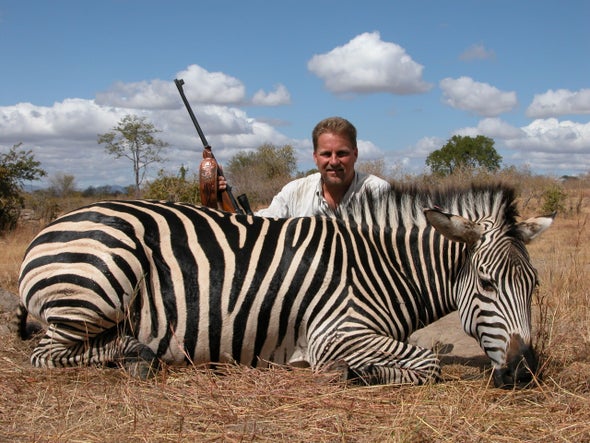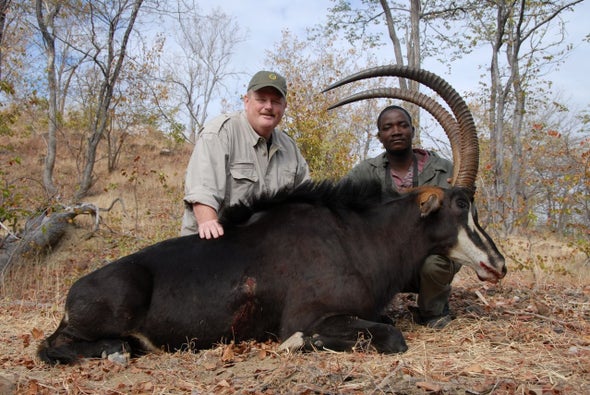A Passion for Plains Game
My first African animal was not a looming tusker or charging buffalo, but a common waterbuck.
By Dave Fulson • Nov 14, 2025
Africa... my business, my favorite hunting destination, and home to a treasure chest of wonderful memories that stretch
over three very intense decades of travel and hunting throughout her vast game fields.

I had been dreaming of, reading about, and falling in love with the very idea of Africa from about the time this blue-collar kid from Hurst, Texas entered his teen years. I was given a copy of Robert Ruark's classic book Horn of the Hunter, which chronicled his first safari in the 1950s, and brother, I was sold!
During that wonderful read, I was transported to an exotic destination called Tanganyika, and during page turns, walked side by side with a young PH named Harry Selby, whose life would never be the same after Ruark immortalized him as “the best professional hunter” in all of Africa.
Today, that worn-out first edition is among my most treasured possessions. It was personally signed by the great Selby himself after we shared a most memorable afternoon at his home in Botswana. Harry has passed now, but will live forever through the book, which will no doubt ignite others, as it did me, to follow their own dreams to the Dark Continent for the first time.
In a fantastic twist of luck, my first safari was in the same country that, with Kenya, made up Ruark's freewheeling first safari, Tanzania. My first African animal was not a looming tusked or charging Cape buffalo, but a common waterbuck, the client I was filming for kindly allowed me to take—with his .470 Rigby double rifle, no less! A hundred-pound elephant bull in the dust at my feet could not have made a more exciting impression.
That old waterbuck will forever be a cherished memory, and he still holds an honored place in my game room. Yes, to some folks he might only be a plains game species, but he is part of a great classification of game animals that are still the centerpiece of most African safaris today, especially a hunter’s first one or two.
Plains game species can range from the immense bulk of a bull eland to the daintiest dik-dik and duiker. They can be found in all sub-Saharan countries from the dense rainforests of central Africa to the dry Cape mountains of South Africa. The varieties of plains game species are staggering in number, with many common classifications having long lists of sub-classifications.
There are even sub-classifications hunters bestow on plains game to separate them, such as common plains game vs. glamour plains game. Hunters sure enjoy building categories! Examples of “common” plains game are endless, but impala, kudu, zebra, gemsbok, bushbuck, and warthog come to mind. Species like sable, Lord Derby’s eland, bongo, mountain nyala, and the like fall into the glamour plains game category whenever hunters debate their virtues.

The vast majority of safari careers begin with a hunt dedicated to the pursuit of plains game. The two most popular countries for that first safari have long been South Africa and Namibia, and I don’t see that changing.
Both countries are vast, offer a large number of species, feature a wide variety of terrain types, and are affordable. Game ranching is big business in both countries, and landowners understand that sustainable game harvest and a healthy safari industry are much more profitable than livestock.
High fence is a common reality in South Africa, and for good reason. I have hunted high fence properties all across that country and have yet to be morally or ethically compromised in the least. Are there instances where fencing is abused? Yes, but they are obvious and easily avoided with a minimum of research. Fences allow proper management of both game numbers and age groups. They reduce poaching and generally protect the landowner’s investment. Who would stock expensive game on a property where one leap of an animal over a four-strand fence onto the neighboring property would instantly result in a gunshot and a BBQ? Not me.
In the arid Great Karoo area, and up north into the Limpopo country, the ranches tend to be larger than the typical properties in the Cape Mountains, for instance. But there are always exceptions. I used to host clients on a 90,000-acre fenced property in the Karoo region. Once, we took two clients there as it was famous for great gemsbok, a species both desired. But upon seeing the perimeter fence, one of the guys said, “I hope this is not a high fence ranch, because if it is, I’m not hunting.” I said, “Believe me, the fence will play zero part in this hunt. There may be animals that have lived on this ranch for years that have never seen the fence. This is as free range as a fenced ranch can get!”
His friend instantly rolled his eyes and told his buddy to get over it, but neither of us could convince him he was passing up on a great hunt. Eventually, we hunted hard for two days, and the friend shot both gemsboks that I had arranged for—one a 39-inch bull, the other a 43-inch cow. It was a fabulous hunt, with nary a view of the fence once we entered the property. We departed the ranch with one very satisfied client and one pouty client that impressed no one and ultimately cheated himself out of a wonderful hunting experience.

We all have our own ethics and values, and I am no different. But if the property is large enough, and the game has room and cover to consistently avoid detection or escape pressure, I do not flinch an inch to hunt there. You may feel differently, which, of course, is fine.
Namibia is probably about 30 percent fenced, and 70 percent unfenced, if I go by what I have seen in my hunting there. But that’s just a guess, so do not quote me. This big, beautiful country reminds me in many ways of my native Texas. Most of Namibia is sweeping savannah, with hills and valleys that are home to incredible plains game opportunities. The people of Namibia are some of the finest and friendliest in Africa, and the lodges I have visited are both comfortable and beautifully situated into the landscape.
Typical plains game hunts both here and in South Africa are between five to seven days of hunting, but there is great flexibility as you pay a daily rate and then trophy fees on game taken. It is my favorite system by far. Package hunts are also popular. Here is how they work: your daily rate is factored into a package that offers a set number of species you can take. Your PH, accommodations, meals, transportation, and trophy fees are all bundled into one bill, leaving only tipping and dip-and-pack arrangements to settle before you head home. But be warned: do not count on substituting this animal for that one on package hunts. Your outfitter has carefully selected a package that is both profitable for him and appealing to their clients. If you want to add species, you can generally take them in addition to your package deal at regular price if the outfitter has a quota and is agreeable. Be sure to discuss this with the safari outfitter or booking agent long before you leave for your hunt.
Many plains game trophies I have taken—and I am not the exception—are encountered while hunting one species when an unexpected opportunity pops up. Of course, I have also gotten pleasantly sidetracked when hunting dangerous game, when some too-good-to-pass-up plains game animal showed up. Both scenarios will generally happen on longer, dangerous game safaris. I have taken species with calibers as large as a .416 and as small as a .22 Hornet. In fact, shotguns have accounted for many of my smaller critters, like blue duiker and suni, both of which live in very thick cover. A good idea is to carry a box of solids in your big gun in case you run into a smaller critter and do not want to destroy the pelt with your buffalo rifle. I always carry a few solids, just in case. You should too!
It is typical in safari circles that dangerous game gets more ink and TV time dedicated to it than non-dangerous game. Lord knows, we have dedicated much of our lives and two series, SCI's Tracks Across Africa and Hornady’s Dark and Dangerous, to the big brutes of Africa. But never do I take for granted the challenge, beauty, diversity, and pure enjoyment I get from hunting the plains game of Africa. If impala were not so common, they would be one of the most sought-after of African game. A bushbuck gliding around his home territory is on par with the smartest whitetail, and a big kudu bull still gets my heart racing more than a big elk. And that list of comparisons, for me at least, goes on and on. Plains game may not eat you, or even kill you, but they will fill a large section of your safari wish list, and in truth, many wonderful pages in your own book of safari memories. And that is the reason this hunter always has, and always will have, a true passion for plains game.
Stories, Strategy & Safari Wisdom
Go beyond the screen with Dave Fulson’s most insightful writings from over the years.
Each article brings you closer to the skills, stories, and mindset of true African hunting.